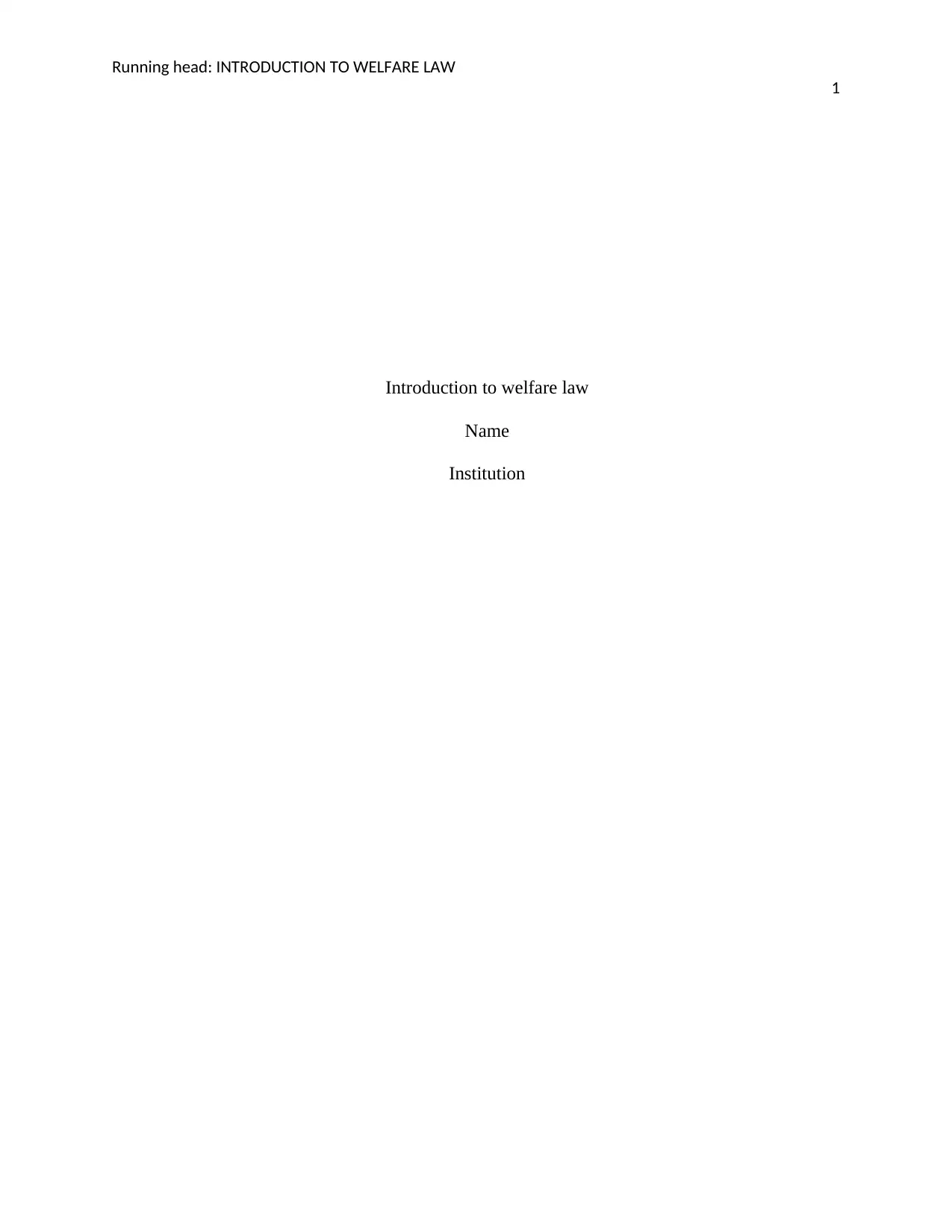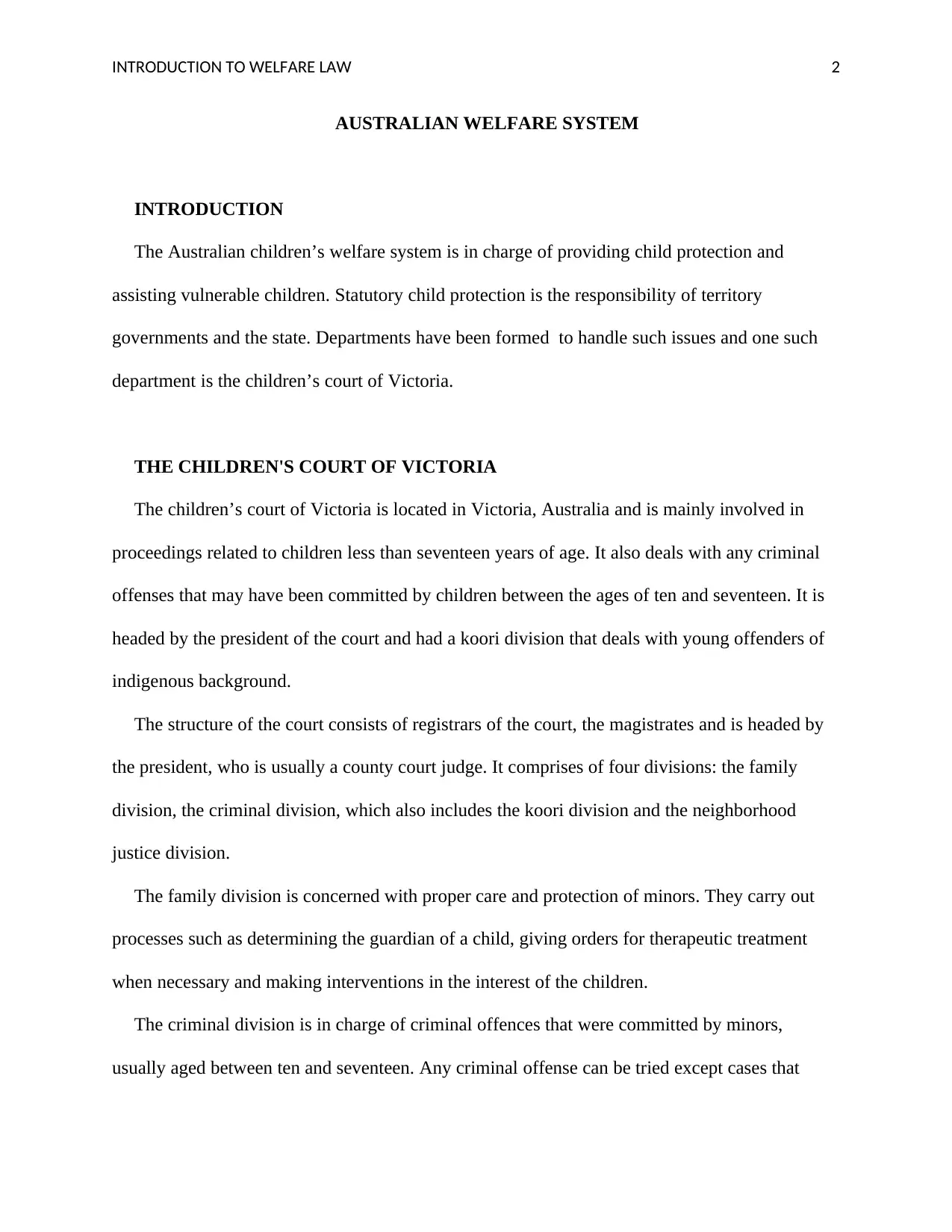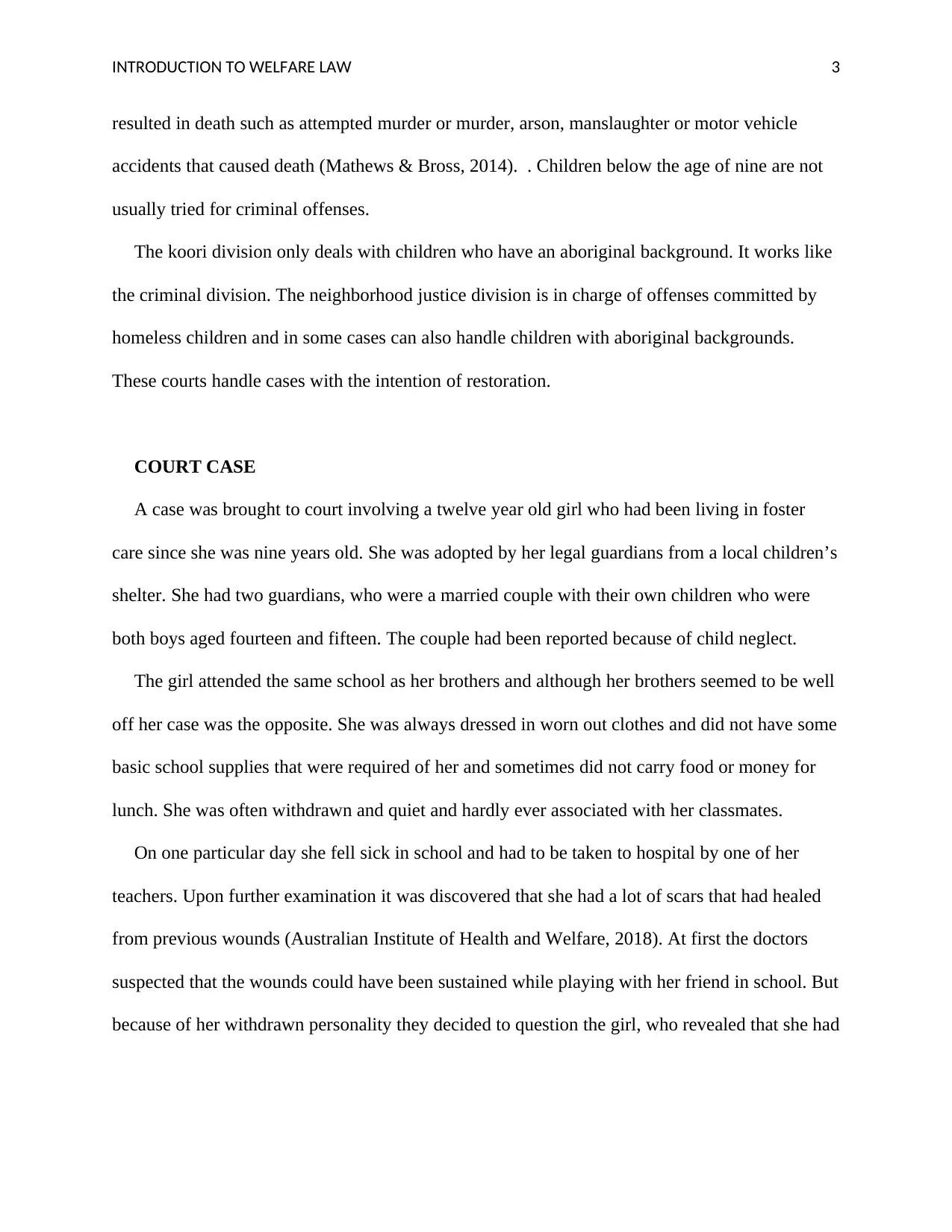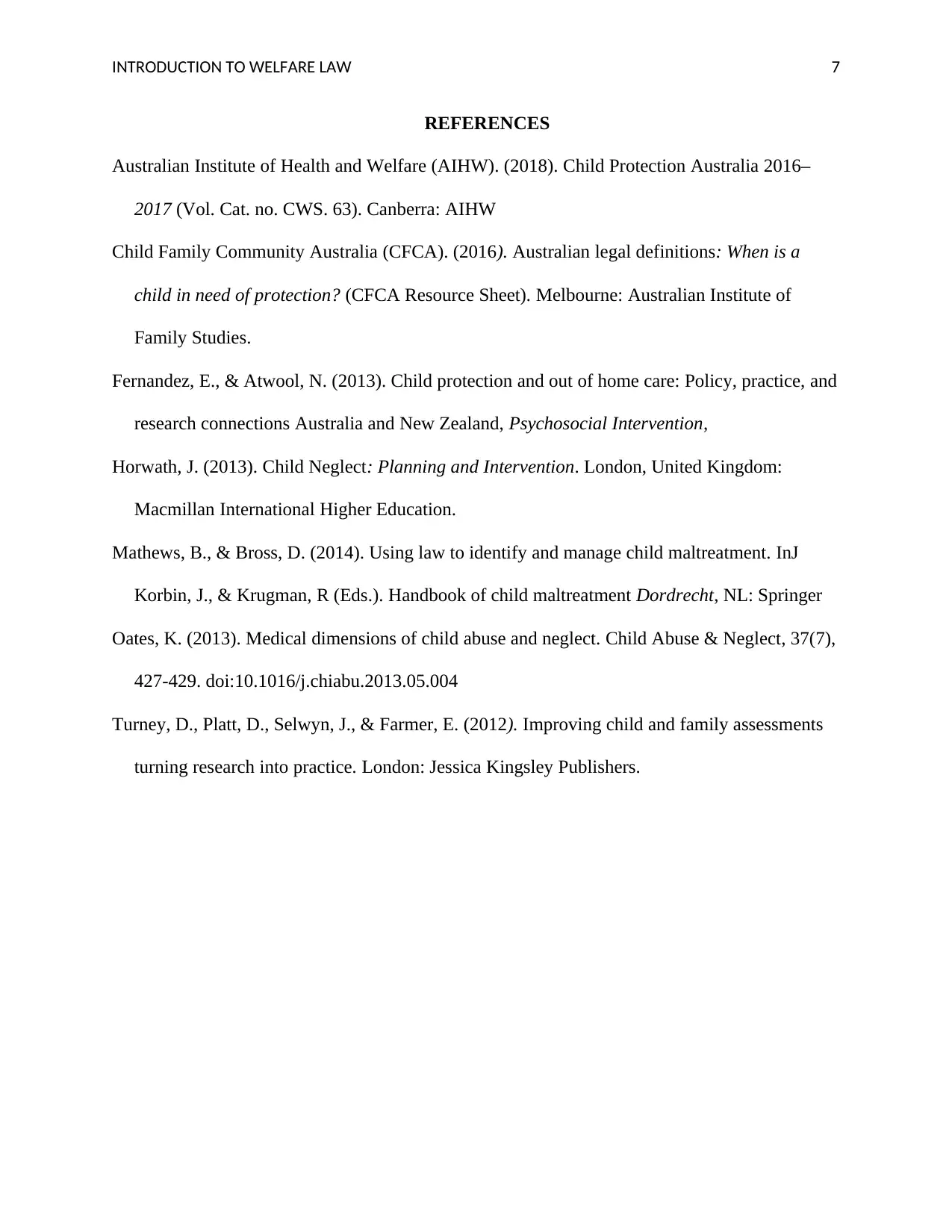Comprehensive Analysis of Australian Welfare Law and Child Protection
VerifiedAdded on 2022/10/18
|7
|1571
|7
Report
AI Summary
This report provides an introduction to Australian welfare law, specifically focusing on child protection and the Children's Court of Victoria. It examines the court's structure and divisions, including the family, criminal, Koori, and neighborhood justice divisions. The core of the report is a detailed analysis of a court case involving a twelve-year-old girl in foster care, who was a victim of child neglect and abuse by her foster brothers. The report explores the legal definitions of child neglect, referencing the World Health Organization's definition and highlighting both physical and emotional neglect. It discusses the responsibilities of adoptive parents, the importance of emotional support, and the legal consequences of child neglect. The report concludes with the court's verdict, the guardians' culpability, and the subsequent actions taken to ensure the girl's safety and well-being, including her return to a children's shelter and the potential for the guardians to reapply for adoption under stricter supervision.

Running head: INTRODUCTION TO WELFARE LAW
1
Introduction to welfare law
Name
Institution
1
Introduction to welfare law
Name
Institution
Paraphrase This Document
Need a fresh take? Get an instant paraphrase of this document with our AI Paraphraser

INTRODUCTION TO WELFARE LAW 2
AUSTRALIAN WELFARE SYSTEM
INTRODUCTION
The Australian children’s welfare system is in charge of providing child protection and
assisting vulnerable children. Statutory child protection is the responsibility of territory
governments and the state. Departments have been formed to handle such issues and one such
department is the children’s court of Victoria.
THE CHILDREN'S COURT OF VICTORIA
The children’s court of Victoria is located in Victoria, Australia and is mainly involved in
proceedings related to children less than seventeen years of age. It also deals with any criminal
offenses that may have been committed by children between the ages of ten and seventeen. It is
headed by the president of the court and had a koori division that deals with young offenders of
indigenous background.
The structure of the court consists of registrars of the court, the magistrates and is headed by
the president, who is usually a county court judge. It comprises of four divisions: the family
division, the criminal division, which also includes the koori division and the neighborhood
justice division.
The family division is concerned with proper care and protection of minors. They carry out
processes such as determining the guardian of a child, giving orders for therapeutic treatment
when necessary and making interventions in the interest of the children.
The criminal division is in charge of criminal offences that were committed by minors,
usually aged between ten and seventeen. Any criminal offense can be tried except cases that
AUSTRALIAN WELFARE SYSTEM
INTRODUCTION
The Australian children’s welfare system is in charge of providing child protection and
assisting vulnerable children. Statutory child protection is the responsibility of territory
governments and the state. Departments have been formed to handle such issues and one such
department is the children’s court of Victoria.
THE CHILDREN'S COURT OF VICTORIA
The children’s court of Victoria is located in Victoria, Australia and is mainly involved in
proceedings related to children less than seventeen years of age. It also deals with any criminal
offenses that may have been committed by children between the ages of ten and seventeen. It is
headed by the president of the court and had a koori division that deals with young offenders of
indigenous background.
The structure of the court consists of registrars of the court, the magistrates and is headed by
the president, who is usually a county court judge. It comprises of four divisions: the family
division, the criminal division, which also includes the koori division and the neighborhood
justice division.
The family division is concerned with proper care and protection of minors. They carry out
processes such as determining the guardian of a child, giving orders for therapeutic treatment
when necessary and making interventions in the interest of the children.
The criminal division is in charge of criminal offences that were committed by minors,
usually aged between ten and seventeen. Any criminal offense can be tried except cases that

INTRODUCTION TO WELFARE LAW 3
resulted in death such as attempted murder or murder, arson, manslaughter or motor vehicle
accidents that caused death (Mathews & Bross, 2014). . Children below the age of nine are not
usually tried for criminal offenses.
The koori division only deals with children who have an aboriginal background. It works like
the criminal division. The neighborhood justice division is in charge of offenses committed by
homeless children and in some cases can also handle children with aboriginal backgrounds.
These courts handle cases with the intention of restoration.
COURT CASE
A case was brought to court involving a twelve year old girl who had been living in foster
care since she was nine years old. She was adopted by her legal guardians from a local children’s
shelter. She had two guardians, who were a married couple with their own children who were
both boys aged fourteen and fifteen. The couple had been reported because of child neglect.
The girl attended the same school as her brothers and although her brothers seemed to be well
off her case was the opposite. She was always dressed in worn out clothes and did not have some
basic school supplies that were required of her and sometimes did not carry food or money for
lunch. She was often withdrawn and quiet and hardly ever associated with her classmates.
On one particular day she fell sick in school and had to be taken to hospital by one of her
teachers. Upon further examination it was discovered that she had a lot of scars that had healed
from previous wounds (Australian Institute of Health and Welfare, 2018). At first the doctors
suspected that the wounds could have been sustained while playing with her friend in school. But
because of her withdrawn personality they decided to question the girl, who revealed that she had
resulted in death such as attempted murder or murder, arson, manslaughter or motor vehicle
accidents that caused death (Mathews & Bross, 2014). . Children below the age of nine are not
usually tried for criminal offenses.
The koori division only deals with children who have an aboriginal background. It works like
the criminal division. The neighborhood justice division is in charge of offenses committed by
homeless children and in some cases can also handle children with aboriginal backgrounds.
These courts handle cases with the intention of restoration.
COURT CASE
A case was brought to court involving a twelve year old girl who had been living in foster
care since she was nine years old. She was adopted by her legal guardians from a local children’s
shelter. She had two guardians, who were a married couple with their own children who were
both boys aged fourteen and fifteen. The couple had been reported because of child neglect.
The girl attended the same school as her brothers and although her brothers seemed to be well
off her case was the opposite. She was always dressed in worn out clothes and did not have some
basic school supplies that were required of her and sometimes did not carry food or money for
lunch. She was often withdrawn and quiet and hardly ever associated with her classmates.
On one particular day she fell sick in school and had to be taken to hospital by one of her
teachers. Upon further examination it was discovered that she had a lot of scars that had healed
from previous wounds (Australian Institute of Health and Welfare, 2018). At first the doctors
suspected that the wounds could have been sustained while playing with her friend in school. But
because of her withdrawn personality they decided to question the girl, who revealed that she had
⊘ This is a preview!⊘
Do you want full access?
Subscribe today to unlock all pages.

Trusted by 1+ million students worldwide

INTRODUCTION TO WELFARE LAW 4
been harassed on numerous occasions by both her brothers. She had reported the incidences to
her guardians but no action had been made.
LAWS CONCERNING CHILD NEGLECT
According to World Health Organization, child neglect can be described as “all forms of
physical and/or emotional ill treatment, sexual abuse, neglect or negligent treatment or
commercial or other exploitation, resulting in actual or potential harm to the child’s health,
survival, development or dignity in the context of a relationship of responsibility, trust or power”
(WHO, 2006).
The girl was facing physical abuse from her brothers and emotional neglect from her parents.
Some of the witnesses testified that there had been a change in her behavior since she started
school when she was nine and had progressively become more quiet and withdrawn. The
emotional neglect had been manifested by their refusal to acknowledge the girls worth and needs
(Horwath, 2013). The family was well off and they managed to provide for the needs of the two
boys. They lived in a large house and even provided toys that the boys could play with.
However, the girl’s needs weren’t met, as seen by the fact that she did not have the necessary
school supplies such as books and stationery and was always dressed in worn out clothes.
Emotional abuse was also manifested in the form of ignoring her (Fernandez & Atwool, 2013).
Despite the fact that she had reported being abused by her brothers several times no action had
been taken against it.
The role of adoptive parents or guardians is to stand in place of a child’s absent parents. They
are expected to love, nurture and raise the child like they are their own. Background checks and
home studies are typically done before the process of adoption is completed. Most of the time a
been harassed on numerous occasions by both her brothers. She had reported the incidences to
her guardians but no action had been made.
LAWS CONCERNING CHILD NEGLECT
According to World Health Organization, child neglect can be described as “all forms of
physical and/or emotional ill treatment, sexual abuse, neglect or negligent treatment or
commercial or other exploitation, resulting in actual or potential harm to the child’s health,
survival, development or dignity in the context of a relationship of responsibility, trust or power”
(WHO, 2006).
The girl was facing physical abuse from her brothers and emotional neglect from her parents.
Some of the witnesses testified that there had been a change in her behavior since she started
school when she was nine and had progressively become more quiet and withdrawn. The
emotional neglect had been manifested by their refusal to acknowledge the girls worth and needs
(Horwath, 2013). The family was well off and they managed to provide for the needs of the two
boys. They lived in a large house and even provided toys that the boys could play with.
However, the girl’s needs weren’t met, as seen by the fact that she did not have the necessary
school supplies such as books and stationery and was always dressed in worn out clothes.
Emotional abuse was also manifested in the form of ignoring her (Fernandez & Atwool, 2013).
Despite the fact that she had reported being abused by her brothers several times no action had
been taken against it.
The role of adoptive parents or guardians is to stand in place of a child’s absent parents. They
are expected to love, nurture and raise the child like they are their own. Background checks and
home studies are typically done before the process of adoption is completed. Most of the time a
Paraphrase This Document
Need a fresh take? Get an instant paraphrase of this document with our AI Paraphraser

INTRODUCTION TO WELFARE LAW 5
grown child may already be scarred before moving in with their foster or adoptive parents and
require more attention and support than a child who was adopted as a toddler. Emotional support
is a thing of importance and should not be ignored. Ignoring a child with this background can
affect their development and even lead to regression (Turney, et. al, 2012).
Child neglect occurs when a child needs protection but does not have it (Child Family
Community Australia, 2016). The difficulty of such cases is usually in proving that there is a
correlation between the parents’ behavior and the outcomes that have been seen on the child.
When it comes to ethical consideration in the case of child neglect, it is the duty of the relevant
authorities to plan for and protect the child. The outcomes that can be seen in a child’s
development or behavior should warrant intervention by legal authorities. The rights of the child
need to be considered (Oates, 2013).
CONCLUSION
After all the evidence was presented and witnesses questioned, the guardians were found
guilty of child neglect. It was concluded that they were responsible for overseeing their sons’
actions and should have taken action as soon as they were made aware of the abuse that the girl
had been going through. The boys were to be tried separately on a different day for the offence
of physical abuse. Because the environment that the girl had been living in was determined to be
hostile then she would be taken back to the children’s shelter. Her guardians were allowed to
visit her under supervision. They lost their legal right as her guardians but were allowed to apply
for the adoption again if they wished to. The process however would be more vigorous and if
their request was granted would have to report to welfare services frequently to prove that they
grown child may already be scarred before moving in with their foster or adoptive parents and
require more attention and support than a child who was adopted as a toddler. Emotional support
is a thing of importance and should not be ignored. Ignoring a child with this background can
affect their development and even lead to regression (Turney, et. al, 2012).
Child neglect occurs when a child needs protection but does not have it (Child Family
Community Australia, 2016). The difficulty of such cases is usually in proving that there is a
correlation between the parents’ behavior and the outcomes that have been seen on the child.
When it comes to ethical consideration in the case of child neglect, it is the duty of the relevant
authorities to plan for and protect the child. The outcomes that can be seen in a child’s
development or behavior should warrant intervention by legal authorities. The rights of the child
need to be considered (Oates, 2013).
CONCLUSION
After all the evidence was presented and witnesses questioned, the guardians were found
guilty of child neglect. It was concluded that they were responsible for overseeing their sons’
actions and should have taken action as soon as they were made aware of the abuse that the girl
had been going through. The boys were to be tried separately on a different day for the offence
of physical abuse. Because the environment that the girl had been living in was determined to be
hostile then she would be taken back to the children’s shelter. Her guardians were allowed to
visit her under supervision. They lost their legal right as her guardians but were allowed to apply
for the adoption again if they wished to. The process however would be more vigorous and if
their request was granted would have to report to welfare services frequently to prove that they

INTRODUCTION TO WELFARE LAW 6
were acting as parents that were fit enough to raise the girl, and to ensure that the incident was
not repeated again.
were acting as parents that were fit enough to raise the girl, and to ensure that the incident was
not repeated again.
⊘ This is a preview!⊘
Do you want full access?
Subscribe today to unlock all pages.

Trusted by 1+ million students worldwide

INTRODUCTION TO WELFARE LAW 7
REFERENCES
Australian Institute of Health and Welfare (AIHW). (2018). Child Protection Australia 2016–
2017 (Vol. Cat. no. CWS. 63). Canberra: AIHW
Child Family Community Australia (CFCA). (2016). Australian legal definitions: When is a
child in need of protection? (CFCA Resource Sheet). Melbourne: Australian Institute of
Family Studies.
Fernandez, E., & Atwool, N. (2013). Child protection and out of home care: Policy, practice, and
research connections Australia and New Zealand, Psychosocial Intervention,
Horwath, J. (2013). Child Neglect: Planning and Intervention. London, United Kingdom:
Macmillan International Higher Education.
Mathews, B., & Bross, D. (2014). Using law to identify and manage child maltreatment. InJ
Korbin, J., & Krugman, R (Eds.). Handbook of child maltreatment Dordrecht, NL: Springer
Oates, K. (2013). Medical dimensions of child abuse and neglect. Child Abuse & Neglect, 37(7),
427-429. doi:10.1016/j.chiabu.2013.05.004
Turney, D., Platt, D., Selwyn, J., & Farmer, E. (2012). Improving child and family assessments
turning research into practice. London: Jessica Kingsley Publishers.
REFERENCES
Australian Institute of Health and Welfare (AIHW). (2018). Child Protection Australia 2016–
2017 (Vol. Cat. no. CWS. 63). Canberra: AIHW
Child Family Community Australia (CFCA). (2016). Australian legal definitions: When is a
child in need of protection? (CFCA Resource Sheet). Melbourne: Australian Institute of
Family Studies.
Fernandez, E., & Atwool, N. (2013). Child protection and out of home care: Policy, practice, and
research connections Australia and New Zealand, Psychosocial Intervention,
Horwath, J. (2013). Child Neglect: Planning and Intervention. London, United Kingdom:
Macmillan International Higher Education.
Mathews, B., & Bross, D. (2014). Using law to identify and manage child maltreatment. InJ
Korbin, J., & Krugman, R (Eds.). Handbook of child maltreatment Dordrecht, NL: Springer
Oates, K. (2013). Medical dimensions of child abuse and neglect. Child Abuse & Neglect, 37(7),
427-429. doi:10.1016/j.chiabu.2013.05.004
Turney, D., Platt, D., Selwyn, J., & Farmer, E. (2012). Improving child and family assessments
turning research into practice. London: Jessica Kingsley Publishers.
1 out of 7
Related Documents
Your All-in-One AI-Powered Toolkit for Academic Success.
+13062052269
info@desklib.com
Available 24*7 on WhatsApp / Email
![[object Object]](/_next/static/media/star-bottom.7253800d.svg)
Unlock your academic potential
Copyright © 2020–2025 A2Z Services. All Rights Reserved. Developed and managed by ZUCOL.



